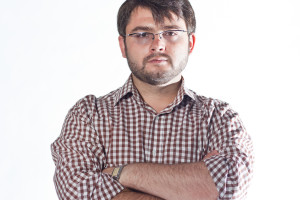During the second half of January, the Center for Visual Arts on 16 Biserica Enei Street hosted the second edition of The National Painting Salon awards exhibition under the patronage of the Romanian Artists’ Union. Two months before, the same space along with the Orizont galleries and Simeza gallery hosted the vast exhibition of the entire Salon, with works of over a hundred active contemporary painters, under the supervision of the curatorial team coordinated by Petru Lucaci, and made up of Marius Barb, Marius Burhan, Florin Mocanu, Vasile Mureşan and Lisandru Neamţu. The Salon itself could be an important part of a potential x-raying of the present situation of painting in Romania because it was able to summarize, in a space smaller than a museum room, the overwhelming majority of trends in this field with its entire suite of themes, directions of attack, approaches and expressions of all ages, from rooted artists to the emerging alike. Alexandra Titu had the role of the art critic for the entire event and she felt the need to split the approaches into three categories for the art catalogue – The object’s authority – flat representation and tridimensional extensions, Painting – representation and non-representation and Investments of the figurative – from realism to subjective autonomy – all under the umbrella-theme of windows and thus subject to openness.
Going back to the winners and seeing the exhibition firsthand, judging it for what it has to offer and not by how deserving the committee found the authors of the works to be, we can clearly ascertain the persistence of some sort of abstract fetish and a discarding of the figure, but figure not as the lexical radical of the figurative, but figure in the narrative sense if you will, as Gérard Genette defines it in the late 60s. In other words, this isn’t about abandoning the subject in its realism, but sadly giving up on metaphors, analogies, on those crutches that guaranteed the steady flow between art, the public and the context that tied the two together. But this statement doesn’t reflect the judges’ tastes, the team of which is joined by Alexandra Titu and Marilena Preda Sânc under Magdei Cârneci’s tutelage, but is rather the point of view of a certain segment of the contemporary trend of art fairs. We aren’t talking about the bigger, canonical art fairs from around the globe, whose logic of value is linked with the stock market, but about the so-called satellite art fairs that are linked to the bigger, more interesting ones that perfectly reflect the daily state of real art, not the speculation filled art where avant-garde is too close to kitsch. The kind of paintings that were awarded at the Salon fit perfectly with these art fairs’ agenda. It’s true, their technique is splendid, but as you walk past the paintings you can already visualize them in your living room, they don’t make you think too much, they’re beautiful, nice, they won’t shake you and if they do, it’s because of the way the viewer feels and not the work itself. From this perspective, we are completely in tuned with Western world.
There are two non-Western exceptions, Aurora Király and Ecaterina Vrana. While Aurora Király unsafely emerges herself in the denuded abyss of memory, innocently searching for the founding moments of a personal mythology and bringing them to the surface modified as a historically gnawed subjectivity, Ecaternia Vrana’s memory seems to be pending in a sort of immemorial post-future that seems possible at the same time. Aurora Király’s acrylic perfectly functions as a metaphor for that specific type of memory erosion that comes in contrast with the perfectly preserved image of due to the photographic paper of personal ages. Ecaterina Vrana’s oil thickens, solidifies, and defines the subjects in a suffocating, heavy, potential paste. The child, the woman and the mother are the three poses presented in The Archive of Happiness (2012) tryptic are photographical self-portraits that seem like intruders when placed along with the rest of the group portraits. It is uncertain if the artists sees herself as awkward in those images or if she is actually the nucleus that generates the rest of the content. Ecaterina Vrana’s self-portraits transpose the self-presentation of femininity on the gloomy realm of threat, suspicion and tortious hints.
Before regretting not so much the ungiven awards, but rather the absence of works that are at least just as relevant as the ones described – like the ones that were exhibited at the Salon by Miriana Ioniţă, Vasile Tolan, Angelica Alexa, Arina-Cristina Bican, Georgian Bărbieru, Irina-Elena Broboană, Marina Capaţîna, Raluca-Ilaria Demetrescu or Claudia Todor (with The Romanian Woman and UE, 2012) – we must highlight the event’s elegance and the rare skill of artistic techniques we witnessed. I have one last advice for the committee: more questioning of the works’ themes, more figuring out for the public, more harshness and more shakes.
The National Painting Salon award winners’ exhibition, second edition.
13-30 January 2015, UAPR, The Center for Visual Arts.
Artists: Gheorghe Anghel, Liviu Nedelcu, Lucian Cioată, Maria Balea, Ioan Augustin Pop, Aurora Király, Carmen-Mirela Trăistaru, Dragoş Bojin, Constantin Rusu, Ecaterina Vrana, Florin Ciubotaru, Ionuţ-Theodor Barbu.
POSTED BY
Igor Mocanu
Igor is a PhD researcher in the Art History department of the National University of the Arts Bucharest / UNARTE, with a dissertation titled Political avant-garde. The other face of Romanian avantgard...
igormocanu.wordpress.com



Comments are closed here.